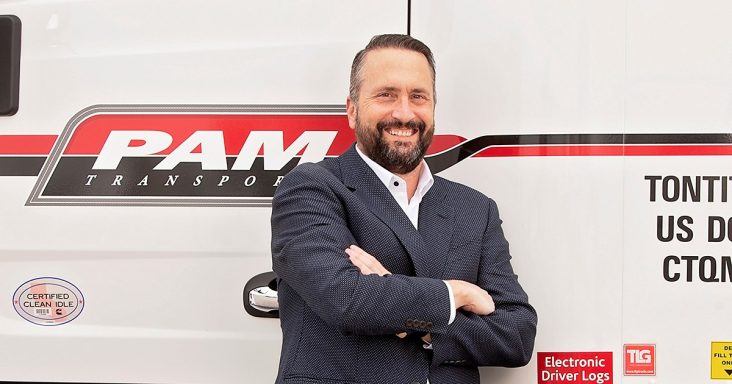P.A.M. revenue rises more than 15% in first quarter; profit at nearly $12 million
by April 21, 2021 4:33 pm 1,485 views

PAM Transport CEO Joe Vitiritto
For the second consecutive quarter, Tontitown-based carrier P.A.M. Transportation Services Inc. posted record results. However, the extreme winter weather in February affected the company’s operations and ability to meet internal targets.
After the markets closed Wednesday (April 21), P.A.M. reported first-quarter net income of $11.94 million, or diluted earnings per share of $2.08, compared to a net loss of $1.3 million, or a loss of 23 cents per share, in the same period in 2020. Revenue rose by 15.2% to $148.85 million, from $129.15 million.
Operating income increased by 43.9% to $13.65 million in the first quarter, from $9.48 million in the same period in 2020. Operating ratio improved to 90.1%, from 90.17%. Revenue per total mile, before fuel surcharge, rose to $1.92, from $1.69. Revenue per truck per week increased to $3,550, from $3,355. P.A.M. had an average of 1,652 company-driver trucks and 368 owner-operator trucks in the first quarter, compared to 1,584 and 544, respectively, in the same period in 2020.
In the company’s logistics operations, revenue rose to $44.78 million in the first quarter, from $20.51 million in the same period in 2020. Operating ratio improved to 89.49%, from 97.53%.
“Although we had a record first quarter and our team navigated the challenges well, we are not satisfied with these results,” said Joe Vitiritto, president and CEO. “Severe weather conditions during February negatively impacted our primary operating lanes and limited our ability to achieve internal targets set for the quarter. We recovered well and regained momentum as we progressed through March but not enough to fully recover the February lost opportunities. We will continue to focus on the challenging driver market and are doing whatever is necessary to find, retain and grow our driving force, which is our most valuable asset. We have been encouraged by our rate improvement results so far this bid season and anticipate additional improvement as we progress through the year. We are also encouraged by the cost control and operating efficiency goals that we believe remain achievable throughout the remainder of the year.”
Shares of P.A.M. (NASDAQ: PTSI) closed Wednesday at $59.62, up $1.72, or 2.97%. In the past 52 weeks, the stock has ranged between $66.29 and $25.68.
BROADER MARKET TRENDS
American Trucking Associations’ advanced seasonally adjusted For-Hire Truck Tonnage Index declined by 5.1% in March, from February. Compared to March 2020, the index fell by 9.5%. Through the first quarter, tonnage decreased by 5%, from the same period in 2020.
“March’s drop comes as somewhat of a surprise,” said Bob Costello, chief economist for American Trucking Associations. “I certainly heard from many fleets that the end-of-quarter rush was good, but early March was soft. Truck freight volumes were also negatively impacted by supply chain issues from the lack of microchips and other inputs. That said, this surprise to the downside does not change my positive outlook going forward.
“Household spending power is strong, and I believe there is plenty of pent-up demand for consumer spending,” he added. “Single-family home construction and stronger manufacturing output, even with the supply chain issues, will help support tonnage this year and beyond.”
Costello told Transport Topics he’s not concerned with the March decline. It is compared to the first month of the COVID-19 pandemic.
“A year ago in March, we were delivering all that toilet paper, and there was a surge of activity,” he said. “There was panic buying, and people were buying meat and toilet paper. Last March was that transition month.
“Halfway through March [2020], everything got shut down, and some freight just fell off the cliff. But there was other freight that just skyrocketed,” Costello added. “It was a difficult year-over-year comparison.”
Costello is projecting GDP growth in the second and third quarters to be nearly 8%, with an annual growth rate of 6%.
“That’s the strongest GDP growth rate going back to the 1980s,” Costello said. “That’s because of our ability to vaccinate people and getting people back to work.”
